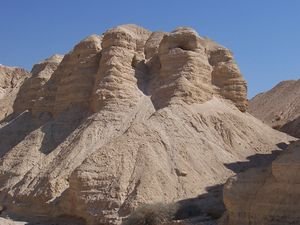Dead Sea Scrolls: Difference between revisions
No edit summary |
No edit summary |
||
| Line 1: | Line 1: | ||
[[File:Caves 4 & 10.jpg|thumb|300px|<div align="center">Caves 4 and 10.</div>]] | |||
Most of the details on this page are taken from [http://en.wikipedia.org/wiki/Dead_Sea_Scrolls ''Wikipedia,'' "Dead Sea Scrolls."] | Most of the details on this page are taken from [http://en.wikipedia.org/wiki/Dead_Sea_Scrolls ''Wikipedia,'' "Dead Sea Scrolls."] | ||
Revision as of 15:52, 21 January 2012

Most of the details on this page are taken from Wikipedia, "Dead Sea Scrolls."
Finding of the Scrolls
- 1946-1947: first scrolls found.
- 1957? Last scrolls found?
- 11 caves near the desert community of Qumran, which is in the "West Bank," which is administered by the Palestinian Authority under the control of Israel.
Contents of the Scrolls
- 972 texts.
- Hebrew, Aramaic, and Greek.
- Both parchment and papyrus manuscripts.
- Linen wrappings.
- Date from around 150 BC to 70 AD.
- Three kinds of scrolls:
- About 40% of the scrolls are "canonical" books from the Hebrew Scriptures. Every book of the Hebrew Scriptures is represented in the Dead Sea Scrolls (except, perhaps, the book of Esther).
- Roughly 30% of the scrolls are "deuterocanonical" books: Tobit, Sirach, part of Exodus from the Septuagint (LXX).
- Many non-canonical texts, some previously known (Enoch, Jubilees), many brand-new: Community Rule (a.k.a. the Manual of Discipline), War Scroll, Pesher ("commentary") on Habakkuk, and the Rule of the Blessing, which comprise roughly 30% of the identified scrolls.
The Scandal of the Scrolls
- Ownership.
- Preservation and display.
- Slow publication of manuscripts and translations. Secrecy restrictions lifted circa 1991.
Lessons Learned
One of the most important benefits of the discovery of the Dead Sea Scrolls is the ability to compare the text of these ancient manuscripts to later versions--prior to the discovery of the Scrolls, the earliest Hebrew manuscripts of the Bible were Masoretic texts dating from the 10th century AD (!). The comparison shows that the scribes did an astonishingly excellent job in copying the text letter-for-letter over the centuries.
The Scrolls are a window into Second Temple Judaism and the inter-testamental period. The Scrolls, therefore, are immensely valuable and of inestimable worth.
We have no other collection to which we can compare the Dead Sea Scrolls. There is no second collection by which we can evaluate this one. An infinite number of lines may be drawn through one data point. The Scrolls fuel feverish and uncontrolled speculation.
References